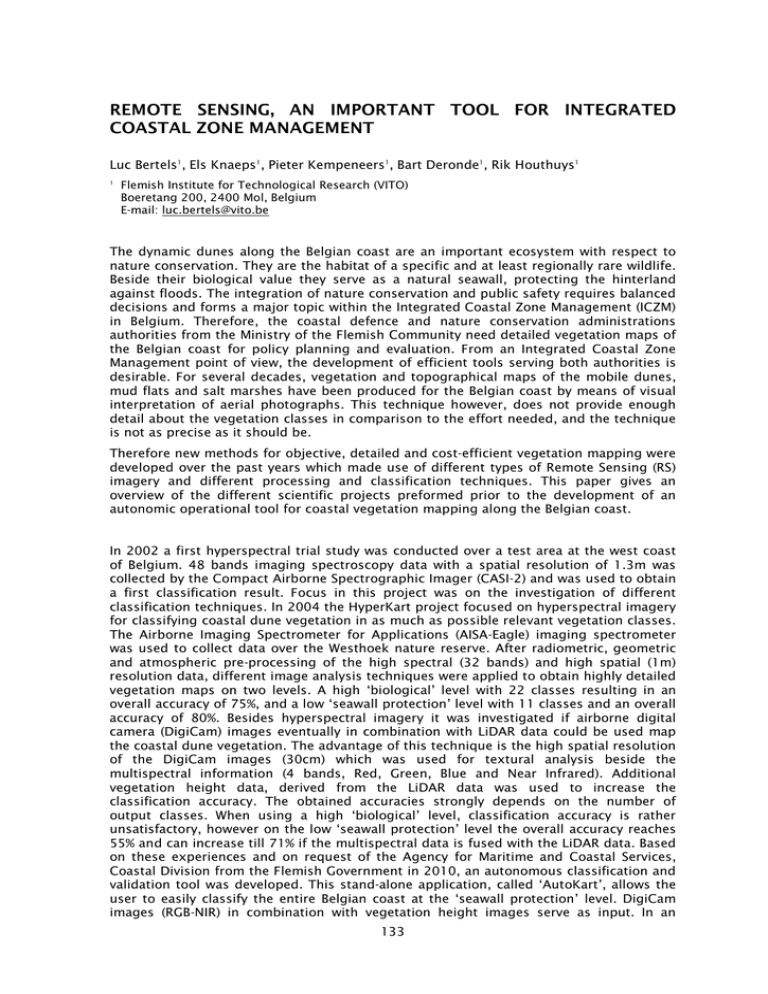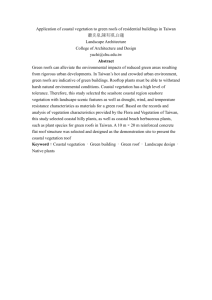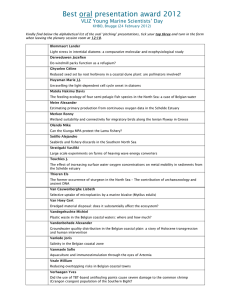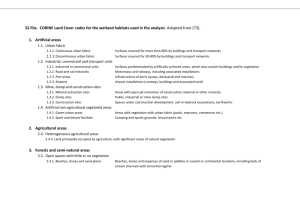REMOTE SENSING, AN IMPORTANT TOOL FOR INTEGRATED COASTAL ZONE MANAGEMENT Luc Bertels
advertisement

REMOTE SENSING, AN IMPORTANT TOOL FOR INTEGRATED COASTAL ZONE MANAGEMENT Luc Bertels1, Els Knaeps1, Pieter Kempeneers1, Bart Deronde1, Rik Houthuys1 1 Flemish Institute for Technological Research (VITO) Boeretang 200, 2400 Mol, Belgium E-mail: luc.bertels@vito.be The dynamic dunes along the Belgian coast are an important ecosystem with respect to nature conservation. They are the habitat of a specific and at least regionally rare wildlife. Beside their biological value they serve as a natural seawall, protecting the hinterland against floods. The integration of nature conservation and public safety requires balanced decisions and forms a major topic within the Integrated Coastal Zone Management (ICZM) in Belgium. Therefore, the coastal defence and nature conservation administrations authorities from the Ministry of the Flemish Community need detailed vegetation maps of the Belgian coast for policy planning and evaluation. From an Integrated Coastal Zone Management point of view, the development of efficient tools serving both authorities is desirable. For several decades, vegetation and topographical maps of the mobile dunes, mud flats and salt marshes have been produced for the Belgian coast by means of visual interpretation of aerial photographs. This technique however, does not provide enough detail about the vegetation classes in comparison to the effort needed, and the technique is not as precise as it should be. Therefore new methods for objective, detailed and cost-efficient vegetation mapping were developed over the past years which made use of different types of Remote Sensing (RS) imagery and different processing and classification techniques. This paper gives an overview of the different scientific projects preformed prior to the development of an autonomic operational tool for coastal vegetation mapping along the Belgian coast. In 2002 a first hyperspectral trial study was conducted over a test area at the west coast of Belgium. 48 bands imaging spectroscopy data with a spatial resolution of 1.3m was collected by the Compact Airborne Spectrographic Imager (CASI-2) and was used to obtain a first classification result. Focus in this project was on the investigation of different classification techniques. In 2004 the HyperKart project focused on hyperspectral imagery for classifying coastal dune vegetation in as much as possible relevant vegetation classes. The Airborne Imaging Spectrometer for Applications (AISA-Eagle) imaging spectrometer was used to collect data over the Westhoek nature reserve. After radiometric, geometric and atmospheric pre-processing of the high spectral (32 bands) and high spatial (1m) resolution data, different image analysis techniques were applied to obtain highly detailed vegetation maps on two levels. A high ‘biological’ level with 22 classes resulting in an overall accuracy of 75%, and a low ‘seawall protection’ level with 11 classes and an overall accuracy of 80%. Besides hyperspectral imagery it was investigated if airborne digital camera (DigiCam) images eventually in combination with LiDAR data could be used map the coastal dune vegetation. The advantage of this technique is the high spatial resolution of the DigiCam images (30cm) which was used for textural analysis beside the multispectral information (4 bands, Red, Green, Blue and Near Infrared). Additional vegetation height data, derived from the LiDAR data was used to increase the classification accuracy. The obtained accuracies strongly depends on the number of output classes. When using a high ‘biological’ level, classification accuracy is rather unsatisfactory, however on the low ‘seawall protection’ level the overall accuracy reaches 55% and can increase till 71% if the multispectral data is fused with the LiDAR data. Based on these experiences and on request of the Agency for Maritime and Coastal Services, Coastal Division from the Flemish Government in 2010, an autonomous classification and validation tool was developed. This stand-alone application, called ‘AutoKart’, allows the user to easily classify the entire Belgian coast at the ‘seawall protection’ level. DigiCam images (RGB-NIR) in combination with vegetation height images serve as input. In an 133 interactive way the user can make trial classifications and validations for observing the obtained results and for fine-tuning the classifier. Seawall protection classes can be easily added or removed depending on the users need whereas sub-areas to be classified can be defined via vector shape-files. Via a build-in visualisation option the user can visualise the used and obtained images, i.e. the input RGB-NIR images and the obtained classification results. References Bertels, L.; Deronde, B.; Kempeneers, S.; Tortelboom, E. 2005. Potentials of airborne hyperspectral remote sensing for vegetation mapping of spatially heterogeneous dynamic dunes, a case study along the Belgian coastline in: Herrier, J.-L. et al. (Ed.) (2005). Proceedings 'Dunes and Estuaries 2005': International Conference on nature restoration practices in European coastal habitats, Koksijde, Belgium 19-23 September 2005. VLIZ Special Publication, 19: pp. 153-163. Bertels, L.; Houthuys, R.; Deronde, B.; Knaeps, E.; Vandevoorde, B.; Van den Bergh, E. 2008. Automatisatie kartering voor opvolging areaal slikken en schorren Zeeschelde: eindrapport. Bijlage: bundel met steekkkaarten [MAP] Afdeling Maritieme Toegang: Antwerpen. maps pp. Deronde, B.; Sterckx, S.; Bertels, L.; Knaeps, E.; Kempeneers, P. 2006. Imaging spectroscopy and integrated coastal zone management: a promising marriage. In: Brebbia, C.A. (Ed.) (2006). Environmental Problems in Coastal Regions VI: Including Oil and Chemical Spill Studies. 6th International Conference on Environmental Problems in Coastal Regions, Rhodes, June 5-7, 2006. WIT Transactions on Ecology and the Environment, 88: pp. 327-339. Kempeneers, P.; Deronde, B.; Bertels, L.; Debruyn, W.; De Backer, S.; Scheunders, P. (2004). Classifying hyperspectral airborne imagery for vegetation survey along coastlines. In: Proceedings of Geoscience and Remote Sensing Symposium, 20-24 september 2004. Anchorage, Alaska. Volume 2. pp. 1475-1478 Kempeneers, P.; Deronde, B.; Provoost, S.; Houthuys, R. (2009) Synergy of airborne digital camera and Lidar data to map coastal dune vegetation. Journal of Coastal Research 25(6): 73-82. Kissiyar, O.; Van Valckenborgh, J.; Deronde, B.; Provoost, S.; Kempeneers, P.; Houthuys, R.; Tortelboom, E. 2005. Vegetatiekartering d.m.v. hyperspectrale vliegtuigopnamen, toegepast op dynamische duingebieden, slikken en schorren = Airborne hyperspectral remote sensing of the dynamic dunes along the Belgian coast (HYPERKART) Versie 2.0. AWZ/Federaal Wetenschapsbeleid/GIS Vlaanderen/Instituut voor Natuurbehoud/VITO/Vlaamse Landmaatschappij[s.l.]. xiii, 180 + maps, cd-rom pp. 134







